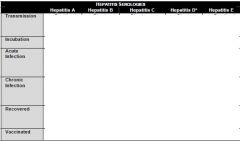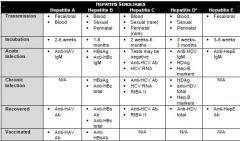![]()
![]()
![]()
Use LEFT and RIGHT arrow keys to navigate between flashcards;
Use UP and DOWN arrow keys to flip the card;
H to show hint;
A reads text to speech;
14 Cards in this Set
- Front
- Back
|
Abdominal Radiography: Abdominal Series
• SBO: • Gallstone ileus: • Hernia: • String of pearls: • Gasless abdomen: • Colitis: • Obstruction versus ileus: |
• SBO: see multiple air-fluid levels
• Gallstone ileus: see air in the biliary tree • Hernia: see bowel extending beyond inguinal line • String of pearls: bowels filled with fluid; high degree of obstruction; very little air • Gasless abdomen: either esophageal obstruction and nothing going through or marked obstruction because the loops are filled with fluid. • Colitis: often do not see haustra. In long-standing UC, see a "lead pipe" (no haustra) image of the sigmoid/descending colon. • Obstruction versus ileus: clues suggestive of obstruction include asymmetric dilation of bowel, no air in the cecum/rectum, a definite point of transition, alternating levels of air-fluid. U/S: Hepatobillary. CT: Masses |
|
|
Ascities: Work up
|
On physical exam will palpate through fluid wave transmission. If you suspect ascities and not on physical exam than look on U/S. If new on set ascities have to perform paracentesis. If patient is cirrhotic with fever, leukocytosis, and altered mental status have to rule out infection. Send ascities fluid for cell count, albumin, protein, bacterial culture. Others LDH, glucose amylase, cytology, AFB.
|
|
|
Ascities: SAAG
|
SAAG = Serum albumin - Ascities albumin
High gradient >1.1g/dl (cirrhosis, alcoholic hepatitis, cardiac ascities, fulminant hepatic failure, budd chiari syndrome, massive hepatic metastases, veno occlusive disease, portal vein thrombosis, myxedema, fatty liver) Low gradient <1.1 - (Nephrotic syndrome, peritoneal carcinomatosis, pancreatic ascities, TB peritonitis, billiary ascities, collagen vascular disease |
|
|
Ascities: Treatment
|
Dietary salt restriction. Spironolactone 100mg daily and furosemide 40mg daily. Fluid restriction only if hyonatremic.
|
|
|
Paracentesis: Indications
|
• Indications for Diagnostic Paracentesis
• New onset ascites • Patients with ascites and fever, leukocytosis or other signs/symptoms of infection • Patients with cirrhosis who have ascites at the time of hospitalization • Patients with cirrhosis and ascites who have worsening of their clinical condition or deterioration in laboratory parameters (i.e. acidosis, azotemia) • Indications for Therapeutic Paracentesis • Tense ascites • Respiratory distress |
|
|
Spontaneous Bacterial Peritonitis: Definition
|
>250 PMN or WBC >500cells/mm3 with positive fluid culture.
Culture negative neutrocytic ascities: PMN count >250cells/mm3 with neative fluid culture subtract 1PMN for ever RBC. |
|
|
SBP: Common Pathogens and Risk Factors
|
E. coli. K. pneumoniae. Enterobacteriaceae, strep pneumoniae. Enterococcus.
Sever liver disease. GI hemorrhage. Prior SBP. Ascitic fluid protein <1g/dL |
|
|
SBP: Clinical Signs, Diagnosis, Treatment
|
Fever, ascities, altered mental status, vomiting, diarrhea, and abdominal pain.
Diagnosis with abdominal paracentisis Treat with antibiotic, cephalosprin (ceftriaxone or cefotaxime) high dose 2gm/day. Prophylaxisis Cipro 750mg PO weekly |
|
|
Hepatic Encephalopathy: Diagnosis and Percipating Factors, Treatment
|
Any patient with abnormal liver function and altered mental status. Patient will have asterixis on physical exam and elevated serum ammonia levels. Precipating factors include GI bleeding, infection, increased dietary intake, azotemia, constipation, volume depletion, hypoglycemia.
|
|
|
Hepatic Encephalopathy: Treatment
|
Correct precipitating cause. Lactulose 30cc TID titrate up to 3-4 soft bowel movements a day.
|
|
|
• Liver Tests
• Aminotransferases (AST, ALT): • ALT (SGPT) • AST (SGOT) • High levels of AST and ALT (about 10× normal) • In alcoholic liver disease, • Alkaline phosphatase: • Albumin and prothrombin time: • Bilirubin: |
• Liver Tests
• Aminotransferases (AST, ALT): • ALT (SGPT) is more specific for the liver • AST (SGOT) can be derived from the liver, heart or skeletal muscle • High levels of AST and ALT (about 10× normal) usually indicate acute hepatocellular injury • In alcoholic liver disease, AST and ALT are generally modestly elevated (about 5-6× normal) and the AST/ALT ratio is around 2 • Alkaline phosphatase: derived from liver, intestine, bone, kidney, and placenta. • GGPT, 5’-nucleotidase are more “liver specific” enzymes • Alkaline phosphatase is increased in biliary obstruction, cholestasis, and space occupying lesions • Albumin and prothrombin time: markers of synthetic function • Bilirubin: marker of clearance |
|
|
Patterns of LIver INjury
• Hepatocellular: • Cholestasis: • Biliary obstruction • Isolated Hyperbilirubinemia: • Conjugated: • Unconjugated: • Infiltrative: |
• Hepatocellular: ↑↑ aminotransferases + ↑ alkaline phosphatase ± ↑ bilirubin
• Viral, autoimmune, or drug-induced hepatitis, ischemic, toxic, hereditary, nonalcoholic steatohepatitis (NASH) • Cholestasis: ↑↑alkaline phosphatase + ↑ bilirubin ± ↑ aminotransferases • Hepatocellular dysfunction: • Biliary epithelial damage from hepatitis, cirrhosis • Intrahepatic cholestasis from medications, sepsis, primary biliary cirrhosis, CHF • Biliary obstruction • Isolated Hyperbilirubinemia: • Conjugated: impaired excretion (hepatocellular injury, Dubin-Johnson) • Unconjugated: overproduction (hemolysis) or impaired conjugation (Gilbert’s, Crigler-Najjar) • Infiltrative: ↑ alkaline phosphatase ± ↑ |
|
|
Abnormal LFT Pneumonic
|
• Autoimmune hepatitis/Hepatitis A
• Hepatitis B • Hepatitis C • Drugs/Medications: acetaminophen, NSAIDs, antibiotics, statins, anti-epileptics, anti-TB. • EtOH • Fatty Liver/Nonalcoholic steatohepatitis • Granulomatous • Hemochromatosis/Wilson’s/α1-antitrypsin deficiency |
|

|

|

